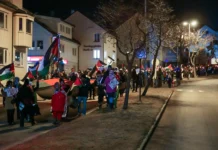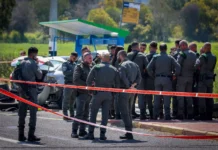Israel found that it had to split its attention this week between its border with Syria, where tensions are high but the risk of escalation is low, and its border with the Gaza Strip, where the potential for escalation is very high, but the threat level is much lower.
The number of security incidents on both borders was unusually high, and sometimes resembled an ongoing conflict. The challenge Israel is facing on both borders is maintaining deterrence without actually going to war.
Israel’s concern lies in two circles and in a broader perspective, in three.
The first circle is tactical and it is currently being waged in the Golan Heights, where the Syrian army is in the midst of a massive offensive to recapture the border area from rebels.
The majority of the territory is already under Syrian President Bashar Assad’s control. Some areas surrendered without a fight to avoid being pummeled to the ground. Villages whose residents insist on resisting the Syria army receive the familiar treatment, which over the past seven years has left hundreds of thousands of Syrians dead across the war-torn country.
The majority of the fighting is currently being waged between the Syrian army and the Khalid ibn al-Walid Army, a Salafi jihadist group affiliated with the Islamic State group.
Israel is not a party to this fight. Its rumored ties with Syrian rebel groups are no longer relevant and any effort vis-à-vis the local population is mainly humanitarian. But Israel has no intention of containing the ricochets of the Syrian civil war.
IDF policy has always been to retaliate over every case of errant Syrian fire that hit Israeli territory. Now, as the Syrian army’s grip on the other side of the border grows stronger that policy is more important than ever.
The fighting on the Syrian side of the Golan border challenged the IDF three times this week: The first time was on Monday, when Syrian missiles launched at rebel forces triggered the David’s Sling defense system, whose operational debut proved a failure; the second time was on Tuesday, when a Syrian fighter jet inadvertently breached Israeli airspace and was shot down; and the third time was on Thursday, when suspected ISIS rockets fired at Syrian forces hit the Sea of Galilee.
Israel was not the target in either case but retaliated in all three. The rationale for that is simple – there are no minor violations of the 1974 cease-fire agreement between Israel and Syria, and Israel will not elasticize its policy on the matter. After all, any sign that Israel’s air defenses are less than complete could be exploited by far more hostile elements, such as Iran and Hezbollah.
This policy will likely be maintained in the future, but it is doubtful it could trigger a security escalation. The Syrian army is battered and bruised by the relentless civil war and it has no interest in taking on the IDF.
This policy also plays an important part in the second circle, which is waged much farther from the northern border and seeks to prevent Iran from entrenching itself militarily in Syria.
In this respect, the past week was highly complex.
From a military standpoint, the Israeli strikes on Iranian assets in Syria continued, including – according to foreign media reports – on a major weapons production facility.
From a diplomatic standpoint, Israel was unable to convince Russia that Iran is a problem, rather than a solution. Russian Foreign Minister Sergey Lavrov and Chief of Staff Gen. Valery Gerasimov, who visited Israel this week suggested allowing Iranian forces to deploy 100 kilometers (62 miles) from the border – an improvement over a prior, 80-kilometer (50-mile) proposal – but Israel refused, as this was merely a minor difference that, given their firepower, would have no real impact on the Iranians.
It is doubtful that Israel alone could thwart Iran’s plans to tighten its grip on Syria. To truly achieve that it needs the United States and Russia, which is why it is taking a great interest in the third, strategic circle, which involves U.S.-Russian talks about Syria’s future.
It is there – and there alone – that the question of Iran’s presence in Syria will be decided. Israel may be able to disrupt Iran’s efforts in Syria in a myriad of ways, but without the help of world powers, it will find it exceedingly difficult to remove Iran from Syria.
Under these circumstances, the northern sector will continue to engage Israel intensively even after the Syrian army completes its takeover of the country’s southwest. In the post-war era, the IDF’s activity will be more complex, because Assad and his forces will have gained confidence. For this reason, if Israel does not want to wake up to a reality where its hands are tied, it must shape the rules of the game it wishes to apply without delay – and make them clear to both Washington and Moscow.
The end of optimism
Meanwhile, on the Gaza border, Israel’s patience is wearing thin.
Last weekend’s flare-up triggered a massive Israeli strike on Hamas targets and prompted the terrorist group to reach out to Egypt and ask for a cease-fire. This, together with a sharp decrease in Palestinian arson terrorism, gave Israel the impression that calm could be restored to the area without a full-scale military operation.
This slight optimism was shattered Wednesday when a Palestinian sniper shot and wounded an IDF officer whose troops were trying to keep a group of Gazan children away from the border.
While the gunman was an operative affiliated with one of the smaller, rogue terrorist groups in Gaza, the message this incident sent was both clear and highly problematic, namely that Hamas is either unable or unwilling to enforce the cease-fire, and that the Palestinian terrorists are eager to recreate last weekend’s successful slaying of an Israeli soldier.
Givati Brigade Staff Sgt. Aviv Levi, 21, who was killed by a Hamas sniper in a border clash last Friday, was the first IDF fatality on the Gaza front since Operation Protective Edge in 2014.
Many in Israel this week called on the IDF to pummel/crush/topple Hamas. Militarily, Israel has no problem doing that, as the disparity in military might is so dramatic that it would take a great deal of self-flagellation mixed with a fundamental misunderstanding of the situation to conclude that Israel is the one wary of confrontation.
But the question, as always, is bigger than the mere deployment of fighter jets and tanks. This is a matter of policy and Israel, even last week, still had not defined the objectives of a potential war in Gaza, should it be dragged into one.
Outline these objectives is crucial precisely because the next clash is right around the corner. These objectives will determine not only the conflict’s immediate results in terms of property damage and potential casualties but also – and mainly – its long-term results and the ability to change Israel’s reality vis-à-vis Gaza.
For now, things seem to be taking their time. The aid package U.N. Middle East envoy Nickolay Mladenov is trying to put together for Gaza has yet to be completed and even when it is, it would take a great deal of optimism to believe that the Arab countries that pledge their help will stick to their word, especially given that behind the scenes, Palestinian Authority President Mahmoud Abbas is sparing no effort to undermine these moves, knowing it would lead to war.
Israel would be better off running things itself. Contrary to public perception, which can lead one to believe that Israel is constantly dancing to Gaza’s tune, the past few weeks have proven that it is Hamas that succumbs to pressure and is wary of a confrontation.
This can be used to promote a dialogue that could secure significant achievements, from restoring peace and quiet to the Gaza-vicinity communities, through the return of the remains of two IDF soldiers and the two Israelis held by Hamas, to the potential regulation of the weapon smuggling and production issues.
This would require Israel to keep an open mind and pursue strategic – not political – thinking, which would prioritize Israel’s broader interest while making it clear to the public that there is no such thing as a “good war.”

























